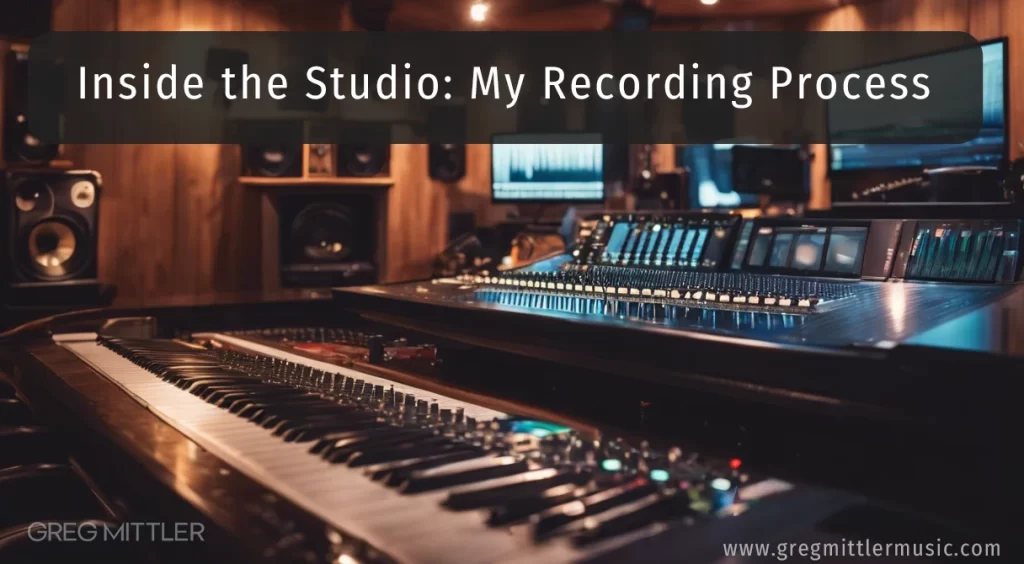
My Recording Process
The process of recording a song, or an entire set of songs, is best approached with a solid plan. In my case, I started with a pool of about 35 songs that I had recorded at home. From this variety, I considered around 16 songs and ultimately selected 6 tracks for the EP. These choices were based on genre, melodic interest, duration, ease of recording (relative recording cost per tune), and instrumentation similarity. This selection process involved narrowing down 100% of my original material to 45%, and then further to 17%.
Choosing your strongest material is an essential part of this process. The songs you don’t select can always be refined and considered for future projects. I had already worked out arrangements for horns, strings, and other instrumentation in the home-recorded versions. Most of the percussion and instrumentation was contained within MIDI files, ready for the next stage of the recording process.
All vocal data and a few acoustic lead/rhythm guitar tracks were WAV files, tied to the time base and tempo of the MIDI tracks. I selected a recording studio based on being songwriter friendly and oriented to small groups. I contacted Fandango Recording and sat down with owner/operator Florin who I came to know as Flo. We talked about the project, discussed Recording costs plus Mixing and Mastering cost per hour. I was then able to work out an approximate cost to do the project.
Here is a Step by Step Breakdown:
From MIDI to Audio
The journey from a song’s initial MIDI files to the final mastered audio is intricate and rewarding. Here’s a detailed look at the process we followed for each track, starting with the separation of MIDI files.
Step 1: Organizing and Loading MIDI Files
Once we had the MIDI files for each song separated, we loaded them into Flo’s digital recording system, Cubase, which was running the latest version at the time. This organization set the stage for the next steps in the recording process.
Step 2: Choosing Instrumentation
We began with the foundational bed tracks: Bass Kick Drum and Bass Guitar. At Fandango Recording, we had access to an extensive library of sampled sounds, including drum kits, bass, strings, horns, synths, and even orchestral samples performed by renowned musicians.
Step 3: Auditioning Sounds and Recording
We spent considerable time auditioning the right drum kit and bass guitar sounds. Once selected, Flo used the MIDI tracks to play these samples, recording the audio onto separate tracks. This method replaced each MIDI track with an actual audio track, a process repeated for the various instrumentation on each song. With the drum, bass guitar, and keyboard tracks completed, we were ready for vocals.
Step 4: Preparing for Vocals
To prepare for the vocal recordings, I practised singing the tracks at home for a few days, making notes on harmonies for reference.
Step 5: Recording Vocals
When recording, we tackled the verses and bridge first. Once satisfied with these sections, we moved on to the chorus. This approach allowed for better focus on each part of the song. Flo then provided rough mixes for each song, enabling me to hear how the vocals blended with the instrumentation.
Step 6: Fine-Tuning and Section Changes
During our review sessions, we discussed potential changes, like adding a string part to the first verse of “It Would Not Be You,” which originally began with intro chords. I believe the addition of the la la la vocal start and that first verse string part brought more energy to the song’s beginning.
Step 7: Mixing and Mastering
After weeks of studying the mixes of all six songs, we adjusted the levels of various instruments to ensure they complemented each other and supported the vocals. The mastering process was intense and meticulous, focusing on making each instrument stand out without interfering sonically with others.
Final Thoughts
I was particularly pleased with how “Relentless” turned out, capturing the essence and energy I felt while writing it. This project, though smaller in scope compared to a full album, underscored the collaborative nature of music production. A big thank you to Flo for his invaluable creative input.
By following these steps, we transformed raw MIDI data into a polished, professional audio product. Each phase of the process, from selecting instrumentation to mastering, played a crucial role in achieving the final sound.

